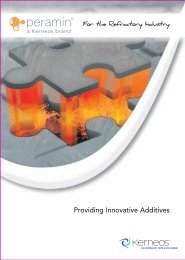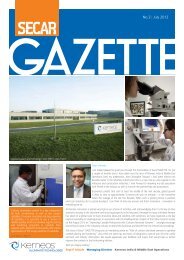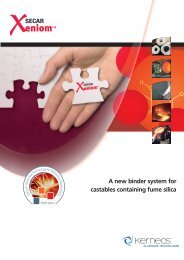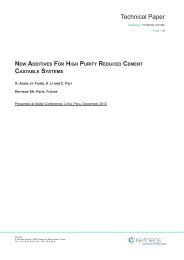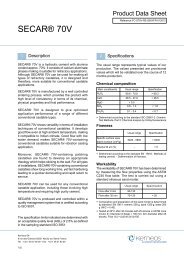Download the document - SECAR®, solutions for refractories
Download the document - SECAR®, solutions for refractories
Download the document - SECAR®, solutions for refractories
You also want an ePaper? Increase the reach of your titles
YUMPU automatically turns print PDFs into web optimized ePapers that Google loves.
Technical Paper<br />
Reference : TP-GB-RE-LAF-096<br />
Page : 1/9<br />
New Spinel Containing Calcium Aluminate Cement<br />
<strong>for</strong> Corrosion Resistant Castables<br />
C. Wöhrmeyer, C. Parr, H. Fryda, J.M. Auvray, B. Touzo, S. Guichard<br />
Kerneos SA, Paris, France<br />
Presented at <strong>the</strong> Unitecr Conference, Kyoto, Japan, 2011<br />
Kerneos<br />
8, Rue des Graviers - 92521 Neuilly sur Seine Cedex, France<br />
Tel. : +33 1 46 37 90 00 - Fax : +33 1 46 37 92 00
Technical Paper<br />
Reference : TP-GB-RE-LAF-096<br />
Page : 2/9<br />
ABSTRACT<br />
Changing <strong>the</strong> microstructure of ladle castables to increase <strong>the</strong>ir service life is <strong>the</strong> target of this<br />
investigation. To achieve this, a novel Calcium Magnesium Aluminate cement has been developed.<br />
This new binder brings microcrystalline spinel phases into regions of <strong>the</strong> microstructure which are<br />
normally occupied by calcium aluminate phases only. The basis of this new calcium magnesium<br />
aluminate cement is a novel multiphase clinker with a microstructure of calcium aluminate phases<br />
embedded in a matrix of microcrystalline magnesium aluminate spinel crystals. The investigation of<br />
this novel calcium magnesium aluminate as a binder in different types of ladle castables has shown that<br />
it significantly improves <strong>the</strong> corrosion and penetration resistance. Both alumina-spinel and aluminamagnesia<br />
castables resist a large range of ladle slag compositions much better when <strong>the</strong>y contain this<br />
new calcium magnesium aluminate.<br />
Kerneos<br />
8, Rue des Graviers - 92521 Neuilly sur Seine Cedex, France<br />
Tel. : +33 1 46 37 90 00 - Fax : +33 1 46 37 92 00
Technical Paper<br />
Reference : TP-GB-RE-LAF-096<br />
Page : 3/9<br />
1 Introduction<br />
Castable developments <strong>for</strong> steel ladles during <strong>the</strong><br />
last three decades have led mainly to aluminaspinel<br />
and alumina-magnesia systems [1-3] . Also,<br />
hybrid materials which combine both systems<br />
have been developed in recent years [4] . It was<br />
found, <strong>for</strong> example by Kantani and Imaiida [5] , that<br />
<strong>the</strong> best compromise between slag penetration<br />
and corrosion resistance can be achieved when<br />
<strong>the</strong> castable contains about 20-40% magnesium<br />
aluminate spinel after firing. Fur<strong>the</strong>rmore, it<br />
was discovered that <strong>the</strong> penetration resistance<br />
increases when <strong>the</strong> spinel size was reduced [6] .<br />
Very fine spinel can be created when magnesia<br />
is added to <strong>the</strong> castable and reacts during firing<br />
with <strong>the</strong> alumina filler to <strong>for</strong>m spinel. However,<br />
<strong>the</strong> magnesia addition often leads to negative<br />
side effects, <strong>for</strong> example, problems during dryout<br />
due to <strong>the</strong> magnesia hydration and high<br />
volume increase as a consequence of <strong>the</strong> spinel<br />
<strong>for</strong>mation. To limit <strong>the</strong> expansion to an acceptable<br />
level, small amounts of silica are often added<br />
to <strong>the</strong> dry-mix which creates a small amount of<br />
liquid phase during firing. That counteracts <strong>the</strong><br />
expansion caused by <strong>the</strong> spinel <strong>for</strong>mation [3,7] . But<br />
<strong>the</strong> silica addition has <strong>the</strong> negative side effect<br />
that it significantly reduces <strong>the</strong> castable strength<br />
at <strong>the</strong> ladle service temperature [8] .<br />
Development work of Falaschi et al. [9] has<br />
led to a patented method to produce and use<br />
calcium magnesium aluminate (CMA) as a<br />
binder in ladle castables. This new method<br />
opens an economic way to produce microcrystalline<br />
spinel simultaneously toge<strong>the</strong>r with<br />
calcium aluminate inside <strong>the</strong> same clinker on an<br />
industrial scale. This can be achieved below <strong>the</strong><br />
sintering temperature of pure spinel and with<br />
crystal sizes as small as spinel that is generated<br />
in-situ inside <strong>the</strong> matrix of an alumina-magnesia<br />
castable. The hydraulic properties of this new<br />
cement are described by Assis et al. [10] . The<br />
impact of this new binder on <strong>the</strong> service life of<br />
model ladle castables is <strong>the</strong> objective of this<br />
present investigation.<br />
CA<br />
CA2<br />
CA<br />
CAC grain<br />
<br />
CA2<br />
MA<br />
MA<br />
MA<br />
MA<br />
CA<br />
MA<br />
CA<br />
CMA grain<br />
Fig. 1 : Microstructure model of a CAC and a<br />
CMA grain (medium grain diameter ca. 15 µm).<br />
2 Experimental Procedure<br />
2.1 Materials tested<br />
This study specifically focuses on <strong>the</strong> wear<br />
resistance of alumina-spinel and of aluminamagnesia<br />
ladle castables and <strong>the</strong>ir properties<br />
at high temperatures. Both systems have been<br />
<strong>for</strong>mulated with pure 70% Al 2<br />
O 3<br />
containing<br />
calcium aluminate cement (CAC) as reference<br />
and with <strong>the</strong> new calcium magnesium aluminate<br />
cement (CMA). In contrast to CAC, <strong>the</strong> CMA<br />
consists mainly of microcrystalline magnesium<br />
aluminate spinel in a multi-component clinker<br />
(Fig. 1). Besides <strong>the</strong> spinel, <strong>the</strong> hydraulic phases<br />
Calcium mono-Aluminate (CA) and Calcium di-<br />
Aluminate (CA2) are present and only traces of<br />
Gehlenite (C2AS). Both cements contain 70%<br />
Al 2<br />
O 3<br />
. The CAC contains 30% CaO, while <strong>the</strong><br />
CMA contains 20% MgO and 10% CaO, only<br />
(Tab. 1).<br />
Kerneos<br />
8, Rue des Graviers - 92521 Neuilly sur Seine Cedex, France<br />
Tel. : +33 1 46 37 90 00 - Fax : +33 1 46 37 92 00
Technical Paper<br />
Reference : TP-GB-RE-LAF-096<br />
Page : 4/9<br />
Both binders have been ground to a specific<br />
surface area of approx. 4000 cm 2 /g (Blaine)<br />
with a median grain size d50 <strong>for</strong> both cements<br />
of about 15 µm.<br />
Model castables as shown in Tab. 2 have<br />
been used to carry out this investigation. Two<br />
different types of model castables have been<br />
selected. Castables MA1 and MA2 use prereacted<br />
sintered spinel. Castables M1 and M2<br />
contain free sintered MgO (Periclase) which<br />
reacts to <strong>for</strong>m spinel in-situ during castable<br />
firing. Castables MA1 and M1 use CAC as <strong>the</strong><br />
binder while MA2 and M2 apply <strong>the</strong> new CMA<br />
binder. The amount of binder has been chosen<br />
in a way that <strong>the</strong> overall CaO content of all 4<br />
castables amounts to 1.7%, thus all 4 castables<br />
are Low Cement Castables (LCC). The spinel<br />
content after firing is in all cases around 23%. A<br />
polycarboxylate e<strong>the</strong>r (PCE) has been chosen<br />
to efficiently deflocculate <strong>the</strong> castables at a<br />
very low amount of mixing water. The amount<br />
of water and PCE has been adjusted in order to<br />
achieve <strong>the</strong> same initial fluidity <strong>for</strong> all 4 recipes.<br />
Table 2 : Alumina-spinel (MA) and aluminamagnesia<br />
(M) model castables with CAC and<br />
with CMA cement.<br />
Castable MA1 MA2 M1 M2<br />
Binder system CAC CMA CAC CMA<br />
Tabular Alumina 0-6 mm 60 61 75.5 70<br />
Reactive Alumina 11 11 11 8<br />
Sintered Spinel 0-1 mm 13 10<br />
Sintered Spinel
Technical Paper<br />
Reference : TP-GB-RE-LAF-096<br />
Page : 5/9<br />
2.2 Experimental apparatus and method<br />
Chemistry and mineralogy have been<br />
determined by using <strong>the</strong> XRF and <strong>the</strong> XRD-<br />
Rietveld methods. The permanent linear<br />
change has been measured after firing samples<br />
<strong>for</strong> 3h at <strong>the</strong> indicated test temperature. Hot<br />
modulus of rupture has been determined<br />
according to European standard EN 993-7.<br />
Dried samples have been heated up to <strong>the</strong><br />
test temperature with 5 K/min and have been<br />
kept 30 min at test temperature prior to <strong>the</strong><br />
hot modulus measurement. Fur<strong>the</strong>r <strong>the</strong>rmophysical<br />
properties have been studied using<br />
110°C dried cylindrical samples in <strong>the</strong> test<br />
furnace as specified in EN 993-8. Unlike in <strong>the</strong><br />
Refractoriness under Load measurement, <strong>the</strong><br />
samples have been heated up with a load of<br />
only 0.05 MPa up to 1550°C to measure <strong>the</strong><br />
<strong>the</strong>rmal expansion. At 1550°C <strong>the</strong> samples<br />
have been kept <strong>for</strong> 1h be<strong>for</strong>e being cooled down<br />
to 1000°C. Then, at 1000°C, a load of 0.2 MPa<br />
has been applied and <strong>the</strong> samples heated up<br />
again to study <strong>the</strong> refractoriness under load.<br />
The corrosion and penetration resistance<br />
against different slags was tested in a laboratory<br />
rotary kiln according to ASTM C874-99. The<br />
test specimens were prepared using a bigger<br />
mixer <strong>the</strong>n those <strong>for</strong> <strong>the</strong> physical properties.<br />
The higher mixing energy in that mixer allowed<br />
a fur<strong>the</strong>r reduction of water. For castables MA1<br />
and MA2 3.9% water and <strong>for</strong> M1 and M2 4.0%<br />
water was sufficient. The vibrated samples were<br />
<strong>the</strong>n cured <strong>for</strong> 24h at 20°C, dried at 110°C, and<br />
<strong>the</strong>n pre-fired <strong>for</strong> 5h at 1550°C.<br />
The specimens were installed in <strong>the</strong> laboratory<br />
rotary kiln where <strong>the</strong>y were heated up to 1550°C<br />
again and kept at that temperature <strong>for</strong> 30 minutes<br />
prior to <strong>the</strong> first addition of 900g of slag. 1.7kg/h<br />
of fresh slag was introduced into <strong>the</strong> kiln during<br />
<strong>the</strong> following 5h at 1550°C. The furnace rotated<br />
at a constant speed of 2½ rpm. The furnace<br />
was tilted 3º axially towards an oxy-acetylene<br />
flame burner at <strong>the</strong> lower end of <strong>the</strong> kiln. The<br />
slag pellets were charged into <strong>the</strong> upper end<br />
of <strong>the</strong> tilted rotary kiln. This way, <strong>the</strong> molten<br />
slag washed over <strong>the</strong> lining, finally dripping off<br />
at <strong>the</strong> lower end of <strong>the</strong> furnace. Two different<br />
slags with compositions as shown in Tab.3 were<br />
used. The diameters of <strong>the</strong> specimens be<strong>for</strong>e<br />
and after <strong>the</strong> test were measured to quantify<br />
<strong>the</strong> degree of wear. Corrosion tests were also<br />
conducted in a laboratory induction furnace.<br />
The specimens of <strong>the</strong> test castables lined <strong>the</strong><br />
wall of <strong>the</strong> furnace which was charged with<br />
steel and covered with <strong>the</strong> slags, as shown in<br />
Tab.3. The test temperature was 1600°C. The<br />
steel contained 0.08% C, 1.9% Si, 0.3% Mn,<br />
0.01% S, and 0.02% P. The wear was quantified<br />
by determining <strong>the</strong> ratio between <strong>the</strong> original<br />
cross sectional area of <strong>the</strong> specimens and <strong>the</strong><br />
remaining cross sectional area after <strong>the</strong> test. The<br />
areas were measured using an image analyzing<br />
software. Fur<strong>the</strong>rmore, SEM techniques were<br />
used to study <strong>the</strong> microstructure of <strong>the</strong> castables<br />
and to quantify <strong>the</strong> penetration depth of slag.<br />
Kerneos<br />
8, Rue des Graviers - 92521 Neuilly sur Seine Cedex, France<br />
Tel. : +33 1 46 37 90 00 - Fax : +33 1 46 37 92 00
Technical Paper<br />
Reference : TP-GB-RE-LAF-096<br />
Page : 6/9<br />
Table 3 : Slag compositions (Slag B: BOFslag,<br />
Slag A: Al-killed steel slag).<br />
Al 2<br />
O 3<br />
SiO 2<br />
FeO MnO CaO MgO<br />
Slag B 2 15 19 6 53 5<br />
Slag A 30 5 0.8 0.2 57 7<br />
3 Results and discussion<br />
3.1 Thermo-physical castable properties<br />
The difference between <strong>the</strong> castables with pre<strong>for</strong>med<br />
spinel (MA1, MA2) and those with in-situ<br />
spinel <strong>for</strong>mation (M1, M2) can easily be seen<br />
in Fig.2. While both MA1 and MA2 keep high<br />
volume stability, those with free MgO (namely<br />
M1 & M2) show a significant permanent linear<br />
change after firing at 1550°C due to <strong>the</strong> insitu<br />
spinel <strong>for</strong>mation. However, mix M2, which<br />
contains less free MgO than M1, shows lower<br />
expansion.<br />
Permant Linerar Change<br />
(%)<br />
MA1 (CAC) MA2 (CMA) M1 (CAC) M2 (CMA)<br />
2,0<br />
1,5<br />
1,0<br />
0,5<br />
0,0<br />
-0,5<br />
800 1200 1350 1550<br />
Temperature (°C)<br />
is applied on <strong>the</strong> sample during <strong>the</strong> first heatup<br />
and during 1h soaking at 1550°C followed<br />
by cooling to 1000°C. After this pre-firing<br />
procedure, <strong>the</strong> application of a load of 0.2 MPa<br />
results in an excellent refractoriness under load<br />
with a T 2<br />
of 1680°C <strong>for</strong> <strong>the</strong> CMA containing M2.<br />
While <strong>the</strong> silica free castables MA1 and MA2<br />
show very high hot modulus of rupture (HMOR),<br />
<strong>the</strong> values are quite low in <strong>the</strong> case of M1 and<br />
M2 at 1350°C and 1550°C respectively (Fig. 4)<br />
due to <strong>the</strong> silica content. However, <strong>the</strong> lower<br />
permanent expansion of M2 and <strong>the</strong> presence<br />
of microcrystalline spinel in CMA leave space<br />
<strong>for</strong> fur<strong>the</strong>r recipe optimization with respect to<br />
silica and periclase content to optimize this<br />
<strong>for</strong>mulations’ hot properties.<br />
3.2 Castable microstructures<br />
SEM micrographs of polished matrix samples<br />
fired at 1550°C are shown in Fig. 5. Matrix<br />
samples are derived from <strong>the</strong> castable<br />
<strong>for</strong>mulations given in Table 2 after <strong>the</strong> removal<br />
of any aggregate coarser than 300 µm.<br />
The pores in <strong>the</strong> CAC containing mixes are<br />
significantly bigger than <strong>the</strong> pores in <strong>the</strong><br />
CMA containing mixes. Fur<strong>the</strong>rmore, <strong>the</strong><br />
microcrystalline phases of spinel and calcium<br />
aluminate are more homogeneously distributed.<br />
Whereas in <strong>the</strong> case of CAC, a certain area<br />
in <strong>the</strong> microstructure is occupied by calcium<br />
aluminates alone, <strong>the</strong> corresponding area<br />
is occupied by ultra-fine spinel and calcium<br />
aluminate phases in <strong>the</strong> CMA containing mixes.<br />
Fig. 2 : Permanent linear change of castables.<br />
The measurement of <strong>the</strong> <strong>the</strong>rmo-physical<br />
properties as shown in Fig.3 also indicates<br />
that <strong>the</strong> permanent expansion with M2 is lower<br />
than with M1 when only a load of 0.05 MPa<br />
Kerneos<br />
8, Rue des Graviers - 92521 Neuilly sur Seine Cedex, France<br />
Tel. : +33 1 46 37 90 00 - Fax : +33 1 46 37 92 00
Technical Paper<br />
Reference : TP-GB-RE-LAF-096<br />
Page : 7/9<br />
DL/Lo (%)<br />
DL/Lo (%)<br />
Fig. 3 : Thermo-physical properties of<br />
model. castable M1 (CAC) and M2 (CMA).<br />
Test procedure: see section 2.2.<br />
HMOR (MPa)<br />
2,0<br />
M1 (CAC)<br />
1,5<br />
1,0<br />
0,5<br />
0,0<br />
-0,5<br />
-1,0<br />
-1,5<br />
-2,0<br />
0 400 800 1200 1600<br />
Temperature (°C)<br />
2,0<br />
M2 (CMA)<br />
1,5<br />
1,0<br />
0,5<br />
0,0<br />
-0,5<br />
-1,0<br />
-1,5<br />
-2,0<br />
0 400 800 1200 1600<br />
Temperature (°C)<br />
30<br />
25<br />
20<br />
15<br />
10<br />
5<br />
0<br />
MA1 (CAC) MA2 (CMA) M1 (CAC) M2 (CMA)<br />
1000 1350 1550<br />
Temperature (°C)<br />
Fig. 4 : Hot modulus of rupture of model<br />
castables.<br />
100 µm<br />
MA1 ((CAC))<br />
MA2 ((CMA))<br />
Fig. 5 : Matrix microstructure of model<br />
castables with CAC and CMA (1550°C, 3h).<br />
3.3 Thermo-chemical castable properties<br />
The following results show quite clearly that <strong>the</strong><br />
CMA containing systems achieve both better<br />
corrosion and penetration resistance to slags.<br />
In <strong>the</strong> induction furnace, <strong>the</strong> corrosion of <strong>the</strong><br />
CMA containing mixes was around 50% lower<br />
than <strong>the</strong> CAC containing reference mixes. With<br />
CMA, <strong>the</strong> castables resisted both of <strong>the</strong> tested<br />
slags better than CAC (Fig. 6). A similar trend is<br />
visible in <strong>the</strong> rotary kiln where <strong>the</strong> improvement<br />
was in <strong>the</strong> range of 20% when changing from<br />
MA1 to MA2 resp. and from M1 to M2 (Fig. 7). In<br />
all cases, <strong>the</strong> iron oxide rich slag B caused more<br />
corrosion than slag A. With respect to wear,<br />
castable M2 shows <strong>the</strong> best per<strong>for</strong>mance while<br />
penetration is <strong>the</strong> lowest with MA2 even with <strong>the</strong><br />
iron rich slag B (Fig. 8). This can be of great<br />
advantage not only in <strong>the</strong> ladle wall and floor but<br />
also <strong>for</strong> functional pre-cast products that often<br />
need adhering slag and remaining steel to be<br />
cleaned from <strong>the</strong> working surface by burning<br />
oxygen lances. This can create aggressive ironrich<br />
slags which CMA will resist better than CAC.<br />
The lowest corrosion with <strong>the</strong> typical ladle slag<br />
A was observed with CMA based castable M2.<br />
This type of spinel <strong>for</strong>ming and spinel containing<br />
hybrid castable could have great advantage in<br />
<strong>the</strong> ladle wall and bottom.<br />
Kerneos<br />
8, Rue des Graviers - 92521 Neuilly sur Seine Cedex, France<br />
Tel. : +33 1 46 37 90 00 - Fax : +33 1 46 37 92 00
Technical Paper<br />
Reference : TP-GB-RE-LAF-096<br />
Page : 8/9<br />
Corroded cross section area (%)<br />
16<br />
14<br />
12<br />
10<br />
8<br />
6<br />
4<br />
2<br />
0<br />
Slag B<br />
Slag A<br />
MA1 (CAC) MA2 (CMA) M1 (CAC) M2 (CMA)<br />
Fig. 6 : Corrosion of model castables in<br />
laboratory induction furnace.<br />
Wear (mm)<br />
16<br />
14<br />
12<br />
10<br />
8<br />
6<br />
4<br />
2<br />
0<br />
Slag B<br />
Slag A<br />
MA1 (CAC) MA2 (CMA) M1 (CAC) M2 (CMA)<br />
Fig. 7 : Corrosion of model castables in<br />
laboratory rotary kiln with two different slags.<br />
4 Conclusions<br />
CMA, <strong>the</strong> new calcium magnesium aluminate<br />
cement significantly increases <strong>the</strong> corrosion<br />
and penetration resistance of castables <strong>for</strong><br />
steel ladle applications. This achievement is<br />
based on an innovative microstructure which<br />
brings microcrystalline spinel to places within<br />
<strong>the</strong> matrix microstructure that are normally<br />
occupied by calcium aluminate phases only. With<br />
CMA, smaller pores are <strong>for</strong>med, explaining <strong>the</strong><br />
improved penetration resistance. Homogeneous<br />
distribution of <strong>the</strong> microcrystalline spinel inside<br />
<strong>the</strong> CMA grains within <strong>the</strong> castable matrix<br />
enhances <strong>the</strong> in-situ life of both spinel containing<br />
and spinel-<strong>for</strong>ming castables.<br />
5 Acknowledgements<br />
We would like to thank <strong>the</strong> Kerneos laboratories<br />
in France and China, <strong>the</strong> Wuhan University<br />
of Science and Technology, China, <strong>the</strong> ITMA<br />
institute, Spain, <strong>the</strong> ICAR institute, France, and<br />
<strong>the</strong> BCMC institute, Belgium, <strong>for</strong> <strong>the</strong> support of<br />
this study.<br />
1000<br />
Slag B<br />
Slag A<br />
Penetration (µm)<br />
800<br />
600<br />
400<br />
200<br />
0<br />
MA1 (CAC) MA2 (CMA) M1 (CAC) M2 (CMA)<br />
Fig. 8 : Slag penetration of model castables in<br />
laboratory rotary kiln.<br />
Kerneos<br />
8, Rue des Graviers - 92521 Neuilly sur Seine Cedex, France<br />
Tel. : +33 1 46 37 90 00 - Fax : +33 1 46 37 92 00
Technical Paper<br />
Reference : TP-GB-RE-LAF-096<br />
Page : 9/9<br />
6 References<br />
[1] T. Yamamura et al.: Development of<br />
alumina-spinel castables <strong>for</strong> steel ladles.<br />
Taikabutsu 42, 8 pp 427-434 (1990).<br />
[2] S. Asano et al.: Mechanism of slag<br />
penetration in alumina-spinel castable <strong>for</strong><br />
steel ladle: Taikabutsu 43, 4, pp 193-199<br />
(1991).<br />
[3] H. Naaby, O.Abbildgaard, G. Stallmann, C.<br />
Wöhrmeyer and J. Meidell: Refractory wear<br />
mechanisms and influence on metallurgy,<br />
37 th Int. Colloquium on Refractories,<br />
Aachen, Germany, pp. 198-204 (1994).<br />
[4] K.H. Dott: Monolithic ladle lining at SSAB<br />
Tunnplåt in Luleå, Sweden. RHI Bulletin, 1,<br />
pp 34-37 (2008).<br />
[5] T. Kanatani, Y. Imaiida: Application of an<br />
alumina-spinel castable to <strong>the</strong> teeming ladle<br />
<strong>for</strong> stainless steelmaking. UNITECR’93, pp<br />
1255-1266, (1993).<br />
[6] M. Nakashima, T. Isobe, S. Itose:<br />
Improvement in corrosion of alumina-spinel<br />
castable by adding ultra fine spinel powder.<br />
Taikabutsu, 52,2, pp 65-72, (2000).<br />
[7] T. Bier, C. Parr, C. Revais, M. Vialle : Spinel<br />
<strong>for</strong>ming castables : Physical and chemical<br />
mechanisms during drying. Refractories<br />
Application 4, pp 3-4, (2000).<br />
[8] Y.C. Ko: Development and production of<br />
Al2O3-MgO and AlsO3-spinel castables <strong>for</strong><br />
steel ladles. Mining and Metallurgy, Taipei,<br />
47, 1, pp 132-140.<br />
[9] J.P. Falaschi et al. : Liant du type clinker,<br />
utilisation et procede de fabrication d’un<br />
tel liant. Demand de brevet d’invention,<br />
FR2788762A1, (1999).<br />
[10] G. Assis et al.: Castables with improved<br />
corrosion resistance <strong>for</strong> steel making<br />
applications, Unitecr’11, (2011).<br />
Kerneos<br />
8, Rue des Graviers - 92521 Neuilly sur Seine Cedex, France<br />
Tel. : +33 1 46 37 90 00 - Fax : +33 1 46 37 92 00



